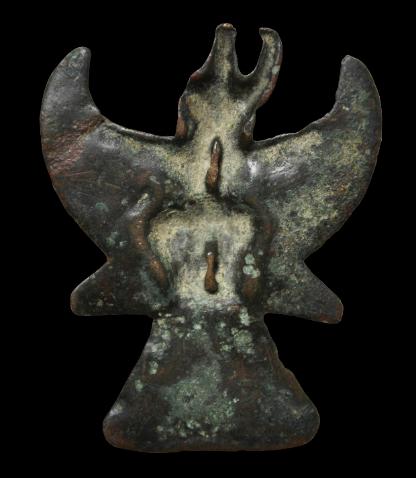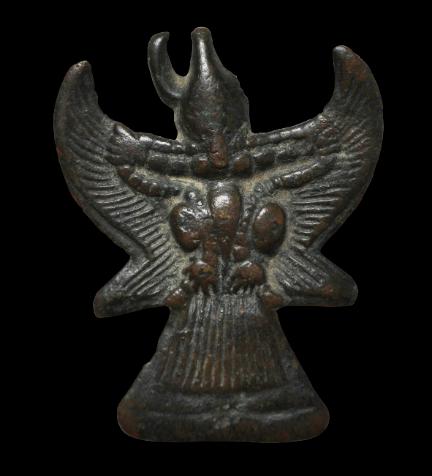
Tibetan Tockcha, Thokcha, Togcha, Thogchag, Thogchak, Tokche, Thog-lcag
Horned & Jewelled Khyung or Garuda Talisman or Tokcha
Tibetcirca 8th-9th century
height: 6.8cm, width: 5.5cm, weight: 24g
This well-worn tokcha shows the Khyung Ngonpo (or the Blue [King] of Birds), a Bon deity that merged into the later Garuda deity imported from India. The figure would have had three bird faces (before heavy ritual wear), two horns on its crowned head (one horn now is missing), wings dramatically outstretched and a long strings of jewels held in the beak. The tokcha dates to the early Tibetan Buddhist period (circa 8th-9th century). The reverse has two small eyelets or lugs to allow the tokcha to be worn either as a pendent or attached to clothing.Tokchas (also spelt as thokcha, tokche, thogchak, thog-lcag, or thogchag) are small ‘found’ ancient, sacred objects that went on to serve as votive talismans, and which were valued for their magical properties. Usually they are of bronze or copper alloy. Many are believed to also contain some meteoric metal. Tibetans highly prized them and would wear them to protect them and to absorb evil. Usually they were hung from the neck or attached to clothing, but also were sewn onto amulet pouches or attached to religious articles. They were also used by Tibetan sharmans – healers, spirit-mediums and magicians – as part of their ‘tools’ of trade.
Particularly effective or powerful
tokchas would be sold on or passed down through the generations. Accordingly, genuine and powerful tokchas should show a great deal of wear, as in the case of the example here.
It is likely that many
tokchas originally were belt fittings or ornaments either from Tibet or from the Eurasian Steppes and Central Asia or Persia, and were traded into Tibet along Silk Road trading routes. Others were purpose-made as talismans, which explains why some genuine tokchas can be very similar. The traditional belief however, was that tokchas were not made by humans and even that they had simply fallen from the sky. The animal motifs employed in many tokchas suggest a linkage to Tibet’s pre-Buddhist Bon past. (Buddhism was introduced to Tibet in the early 7th century.)
Four related
tokchas comprised lot 3056, in Bonham’s New York sale, ‘Indian, Himalayan & Southeast Asia Art’, March 13, 2017. See those
here
here
.
A less elaborate
khyung tokcha is illustrated in Reynolds (1999, p. 79).
The example here is in a stable and wearable condition. As mentioned, it has an exceptional patina and obvious antiquity. It was acquired from the estate of a private English collector who built up a fine collection of
tokchas over his lifetime.
References
Bashkanov, M., M. Bashkanov, P. Petrov, & N. Serikoff, Arts from the Land of Timur: An Exhibition from a Scottish Private Collection, Sogdiana Books, 2012.
Heller, A.,
Early Himalayan Art, Ashmolean Museum, 2008.
Reynolds, V.
et al, From the Sacred Realm: Treasures of Tibetan Art from the Newark Museum, Prestel, 1999.
Provenance
private collection, UK.
Inventory no.: 4431
SOLD
here




